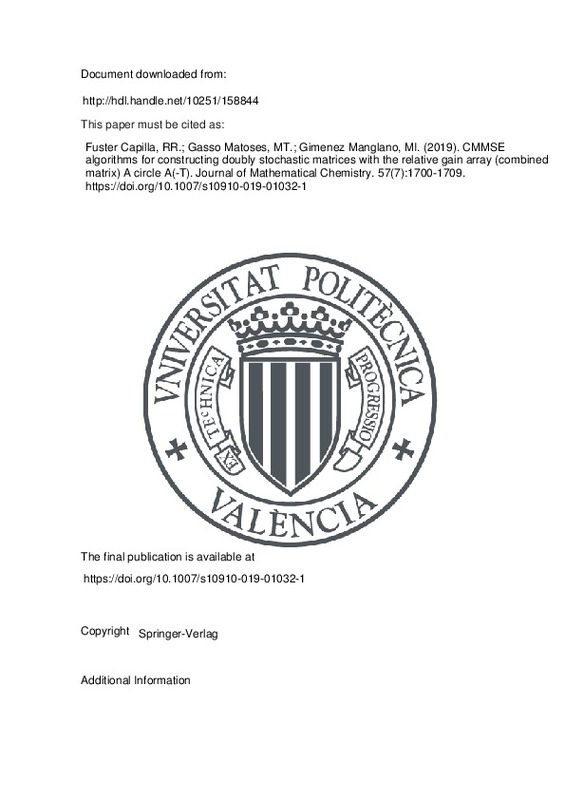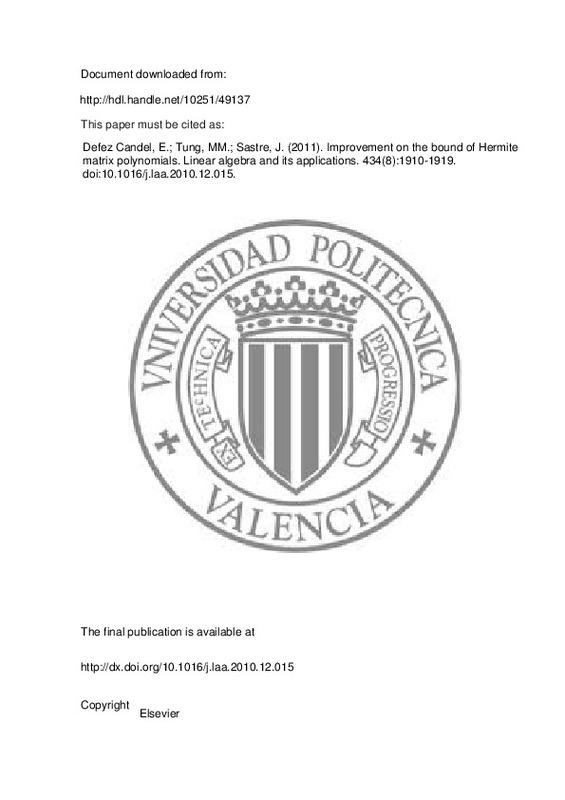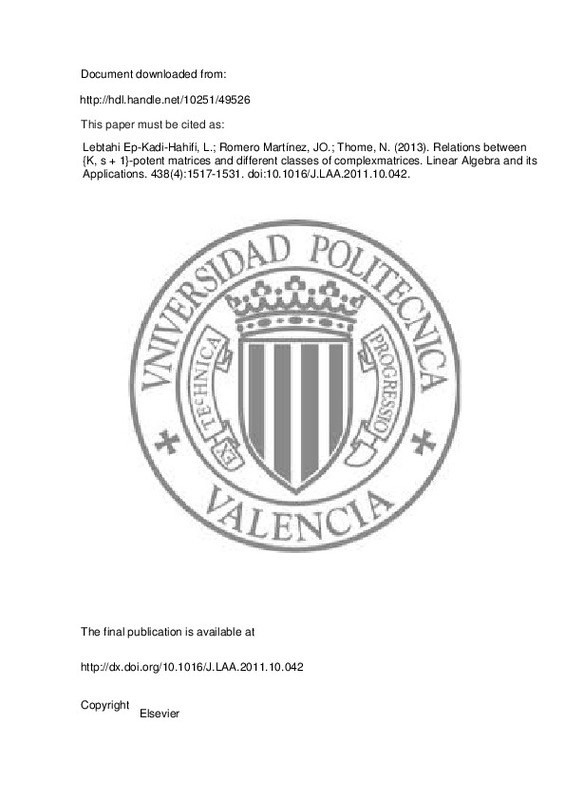JavaScript is disabled for your browser. Some features of this site may not work without it.
Buscar en RiuNet
Listar
Mi cuenta
Estadísticas
Ayuda RiuNet
Admin. UPV
CMMSE algorithms for constructing doubly stochastic matrices with the relative gain array (combined matrix) A circle A(-T)
Mostrar el registro sencillo del ítem
Ficheros en el ítem
| dc.contributor.author | Fuster Capilla, Robert Ricard
|
es_ES |
| dc.contributor.author | Gasso Matoses, María Teresa
|
es_ES |
| dc.contributor.author | Gimenez Manglano, María Isabel
|
es_ES |
| dc.date.accessioned | 2021-01-12T21:02:55Z | |
| dc.date.available | 2021-01-12T21:02:55Z | |
| dc.date.issued | 2019-08 | es_ES |
| dc.identifier.issn | 0259-9791 | es_ES |
| dc.identifier.uri | http://hdl.handle.net/10251/158844 | |
| dc.description.abstract | [EN] The Combined matrix of a nonsingular matrix A is defined by phi(A)=A T where degrees means the Hadamard (entrywise) product. If the matrix A describes the relation between inputs and outputs in a multivariable process control, phi(A) describes the relative gain array (RGA) of the process and it defines the Bristol method (IEEE Trans Autom Control 1:133-134, 1966) often used for Chemical processes (McAvoy in Interaction analysis: principles and applications. Instrument Society of America, Pittsburgh, 1983; Papadourakis et al. in Ind Eng Chem Res 26(6):1259-1262, 1987; Wang et al. in Chem Eng Technol, 10.1002/ceat.201500202, 2016; Kariwala et al. in Ind Eng Chem Res 45(5):1751-1757, 10.1021/ie050790r, 2006; Golender et al. in J Chem Inf Comput Sci 21(4):196-204, 10.1021/ci00032a004, 1981). The combined matrix has been studied in several works such as Bru et al. (J Appl Math, 10.1155/2014/182354, 2014), Fiedler and Markham (Linear Algebra Appl 435:1945-1955, 2011) and Johnson and Shapiro (SIAM J Algebraic Discrete Methods 7:627-644, 1986). Since phi(A)=(cij) has the property of Sigma kcik=Sigma kckj=1,i,j, when phi(A)>= 0, phi(A) is a doubly stochastic matrix. In certain chemical engineering applications a diagonal of the RGA in wchich the entries are near 1 is used to determine the pairing of inputs and outputs for further design analysis. Applications of these matrices can be found in Communication Theory, related with the satellite-switched time division multiple-access systems, and about a doubly stochastic automorphism of a graph. In this paper we present new algorithms to generate doubly stochastic matrices with the Combined matrix using Hessenberg matrices in Sect.3 and orthogonal/unitary matrices in Sect.4. In addition, we discuss what kind of doubly stochastic matrices are obtained with our algorithms and the possibility of generating a particular doubly stochastic matrix by the map phi. | es_ES |
| dc.description.sponsorship | This work has been supported by Spanish Ministerio de Economia y Competitividad Grants MTM2014-58159-P, MTM2017-85669-P and MTM2017-90682-REDT. | es_ES |
| dc.language | Inglés | es_ES |
| dc.publisher | Springer-Verlag | es_ES |
| dc.relation.ispartof | Journal of Mathematical Chemistry | es_ES |
| dc.rights | Reserva de todos los derechos | es_ES |
| dc.subject | Hadamard product | es_ES |
| dc.subject | Combined matrix | es_ES |
| dc.subject | Doubly stochastic matrix | es_ES |
| dc.subject | Hessenberg matrix | es_ES |
| dc.subject | Householder matrix | es_ES |
| dc.subject | Orthogonal matrix | es_ES |
| dc.subject | Unitary matrix | es_ES |
| dc.subject | Relative gain array | es_ES |
| dc.subject.classification | MATEMATICA APLICADA | es_ES |
| dc.title | CMMSE algorithms for constructing doubly stochastic matrices with the relative gain array (combined matrix) A circle A(-T) | es_ES |
| dc.type | Artículo | es_ES |
| dc.identifier.doi | 10.1007/s10910-019-01032-1 | es_ES |
| dc.relation.projectID | info:eu-repo/grantAgreement/AEI//MTM2017-90682-REDT/ES/RED TEMATICA DE ALGEBRA LINEAL, ANALISIS MATRICIAL Y APLICACIONES/ | es_ES |
| dc.relation.projectID | info:eu-repo/grantAgreement/MINECO//MTM2014-58159-P/ES/PRECONDICIONADORES PARA SISTEMAS DE ECUACIONES LINEALES, PROBLEMAS DE MINIMOS CUADRADOS, CALCULO DE VALORES PROPIOS Y APLICACIONES TECNOLOGICAS/ | es_ES |
| dc.relation.projectID | info:eu-repo/grantAgreement/AEI/Plan Estatal de Investigación Científica y Técnica y de Innovación 2013-2016/MTM2017-85669-P/ES/PROBLEMAS MATRICIALES: COMPUTACION, TEORIA Y APLICACIONES/ | es_ES |
| dc.rights.accessRights | Abierto | es_ES |
| dc.contributor.affiliation | Universitat Politècnica de València. Departamento de Matemática Aplicada - Departament de Matemàtica Aplicada | es_ES |
| dc.description.bibliographicCitation | Fuster Capilla, RR.; Gasso Matoses, MT.; Gimenez Manglano, MI. (2019). CMMSE algorithms for constructing doubly stochastic matrices with the relative gain array (combined matrix) A circle A(-T). Journal of Mathematical Chemistry. 57(7):1700-1709. https://doi.org/10.1007/s10910-019-01032-1 | es_ES |
| dc.description.accrualMethod | S | es_ES |
| dc.relation.publisherversion | https://doi.org/10.1007/s10910-019-01032-1 | es_ES |
| dc.description.upvformatpinicio | 1700 | es_ES |
| dc.description.upvformatpfin | 1709 | es_ES |
| dc.type.version | info:eu-repo/semantics/publishedVersion | es_ES |
| dc.description.volume | 57 | es_ES |
| dc.description.issue | 7 | es_ES |
| dc.relation.pasarela | S\392077 | es_ES |
| dc.contributor.funder | Agencia Estatal de Investigación | es_ES |
| dc.contributor.funder | Ministerio de Economía y Competitividad | es_ES |
| dc.description.references | E. Bristol, On a new measure of interaction for multivariable process control. IEEE Trans. Autom. Control 1, 133–134 (1966) | es_ES |
| dc.description.references | R.A. Brualdi, Some applications of doubly stochastic matrices. Linear Algebra Appl. 107, 77–100 (1988) | es_ES |
| dc.description.references | R. Bru, M.T. Gassó, I. Giménez, M. Santana, Nonnegative combined matrices. J. Appl. Math. (2014). https://doi.org/10.1155/2014/182354 | es_ES |
| dc.description.references | J. Cremona, Letter to the Editor. Am. Math. Monthly 4, 757 (2014) | es_ES |
| dc.description.references | M. Fiedler, Relations between the diagonal entries of two mutually inverse positive definite matrices. Czechosl. Math. J. 14, 39–51 (1964) | es_ES |
| dc.description.references | M. Fiedler, T.L. Markham, Combined matrices in special classes of matrices. Linear Algebra Appl. 435, 1945–1955 (2011) | es_ES |
| dc.description.references | F.R. Gantmacher, The theory of matrices (American Mathematical Society, Chelsea, 1960) | es_ES |
| dc.description.references | V.E. Golender, V.V. Drboglav, A.B. Rosenblit, Graph potentials method and its application for chemical information processing. J. Chem. Inf. Comput. Sci. 21(4), 196–204 (1981). https://doi.org/10.1021/ci00032a004 | es_ES |
| dc.description.references | R.A. Horn, C.R. Johnson, Topics in matrix analysis (Cambridge University Press, Cambridge, 1991) | es_ES |
| dc.description.references | C. Johnson, H. Shapiro, Mathematical aspects of the relarive gain array. SIAM J. Algebraic Discrete Methods 7, 627–644 (1986) | es_ES |
| dc.description.references | V. Kariwala, S. Skogestad, J.F. Forbes, Relative gain array for norm-bounded uncertain systems. Ind. Eng. Chem. Res. 45(5), 1751–1757 (2006). https://doi.org/10.1021/ie050790r | es_ES |
| dc.description.references | H. Liebeck, A. Osborne, The generation of all rational orthogonal matrices. Am. Math. Monthly 98(2), 131–133 (1991) | es_ES |
| dc.description.references | T.J. McAvoy, Interaction Analysis: Principles and Applications (Instrument Society of America, Pittsburgh, 1983) | es_ES |
| dc.description.references | B. Mourad, Generalization of some results concerning eigenvalues of a certain class of matrices and some applications. Linear Multilinear Algebra 61, 1234–1243 (2013) | es_ES |
| dc.description.references | A. Papadourakis et al., Relative gain array for units in plants with recycle. Ind. Eng. Chem. Res. 26(6), 1259–1262 (1987) | es_ES |
| dc.description.references | H. Wang et al., Design and control of extractive distillation based on an effective relative gain array. Chem. Eng. Technol. (2016). https://doi.org/10.1002/ceat.201500202 | es_ES |
| dc.description.references | M. Hovd, S. Skogestad, Pairing criteria for decentralized control of unstable plants. Ind. Eng. Chem. Res. 33(9), 2134–2139 (1994). https://doi.org/10.1021/ie00033a016 | es_ES |
| dc.description.references | H. Wang, Y. Li, S. Weiyi, Y. Zhang, J. Guo, C. Li, Design and control of extractive distillation based on effective relative gain array. Chem. Eng. Technol. 39, 1–9 (2016). https://doi.org/10.1002/ceat.201500202 | es_ES |







![[Cerrado]](/themes/UPV/images/candado.png)



